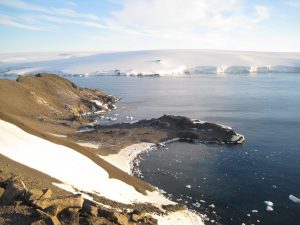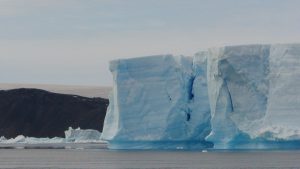63d 11m 41.2s S, 57d 18m 28.6s W (WP097)
Our final stop for our first day in Antarctic waters was at Gourdin Island, just on the east side of the northernmost tip of the Antarctic Peninsula. Here there were harems of fur seals, and hundreds of Chinstrap and Gentoo with a few Adelie penguins. We went on a short hike to the ridge (384 ft) to get a great view of the Antarctic continent and the ice-infested waters. The top of Gourdin Island had a the rusted remains of a lookout or beacon post. I don’t know its dating, but it stood out among the otherwise untouched beautiful wilderness.
The icebergs in this area had ‘tide-marks’ or horizontal striping. These icebergs are ‘beached’ and the residual markings is due to the erosion by ebb & flow of wind & water of being stuck in that place in the ocean.
It was a very fine day as I took in all the new delights. I will admit I was disappointed not to see Elephant Island or the Weddell Sea. A return trip is needed, but then again, it would always be subject to the changing conditions of this amazing place. Changing conditions, I was learning, was the norm, not the exception. Antarctica was living up to its promise of being a place of extremes.






